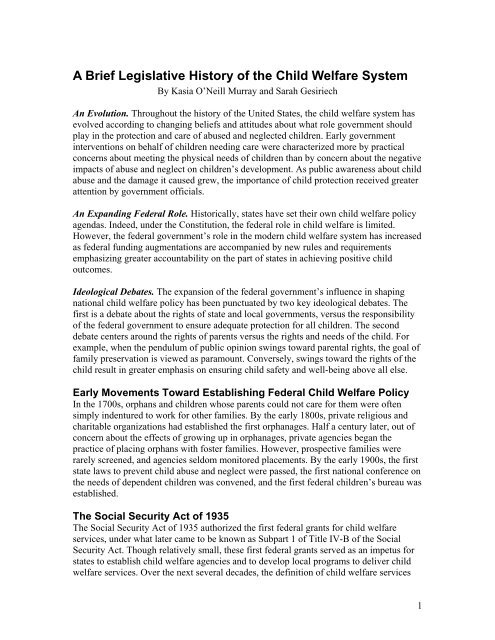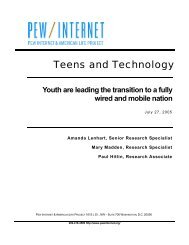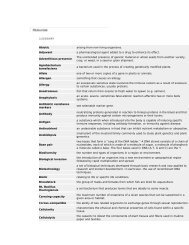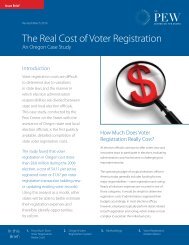Report: A Brief Legislative History of the Child Welfare System
Report: A Brief Legislative History of the Child Welfare System
Report: A Brief Legislative History of the Child Welfare System
Create successful ePaper yourself
Turn your PDF publications into a flip-book with our unique Google optimized e-Paper software.
A <strong>Brief</strong> <strong>Legislative</strong> <strong>History</strong> <strong>of</strong> <strong>the</strong> <strong>Child</strong> <strong>Welfare</strong> <strong>System</strong><br />
By Kasia O’Neill Murray and Sarah Gesiriech<br />
An Evolution. Throughout <strong>the</strong> history <strong>of</strong> <strong>the</strong> United States, <strong>the</strong> child welfare system has<br />
evolved according to changing beliefs and attitudes about what role government should<br />
play in <strong>the</strong> protection and care <strong>of</strong> abused and neglected children. Early government<br />
interventions on behalf <strong>of</strong> children needing care were characterized more by practical<br />
concerns about meeting <strong>the</strong> physical needs <strong>of</strong> children than by concern about <strong>the</strong> negative<br />
impacts <strong>of</strong> abuse and neglect on children’s development. As public awareness about child<br />
abuse and <strong>the</strong> damage it caused grew, <strong>the</strong> importance <strong>of</strong> child protection received greater<br />
attention by government <strong>of</strong>ficials.<br />
An Expanding Federal Role. Historically, states have set <strong>the</strong>ir own child welfare policy<br />
agendas. Indeed, under <strong>the</strong> Constitution, <strong>the</strong> federal role in child welfare is limited.<br />
However, <strong>the</strong> federal government’s role in <strong>the</strong> modern child welfare system has increased<br />
as federal funding augmentations are accompanied by new rules and requirements<br />
emphasizing greater accountability on <strong>the</strong> part <strong>of</strong> states in achieving positive child<br />
outcomes.<br />
Ideological Debates. The expansion <strong>of</strong> <strong>the</strong> federal government’s influence in shaping<br />
national child welfare policy has been punctuated by two key ideological debates. The<br />
first is a debate about <strong>the</strong> rights <strong>of</strong> state and local governments, versus <strong>the</strong> responsibility<br />
<strong>of</strong> <strong>the</strong> federal government to ensure adequate protection for all children. The second<br />
debate centers around <strong>the</strong> rights <strong>of</strong> parents versus <strong>the</strong> rights and needs <strong>of</strong> <strong>the</strong> child. For<br />
example, when <strong>the</strong> pendulum <strong>of</strong> public opinion swings toward parental rights, <strong>the</strong> goal <strong>of</strong><br />
family preservation is viewed as paramount. Conversely, swings toward <strong>the</strong> rights <strong>of</strong> <strong>the</strong><br />
child result in greater emphasis on ensuring child safety and well-being above all else.<br />
Early Movements Toward Establishing Federal <strong>Child</strong> <strong>Welfare</strong> Policy<br />
In <strong>the</strong> 1700s, orphans and children whose parents could not care for <strong>the</strong>m were <strong>of</strong>ten<br />
simply indentured to work for o<strong>the</strong>r families. By <strong>the</strong> early 1800s, private religious and<br />
charitable organizations had established <strong>the</strong> first orphanages. Half a century later, out <strong>of</strong><br />
concern about <strong>the</strong> effects <strong>of</strong> growing up in orphanages, private agencies began <strong>the</strong><br />
practice <strong>of</strong> placing orphans with foster families. However, prospective families were<br />
rarely screened, and agencies seldom monitored placements. By <strong>the</strong> early 1900s, <strong>the</strong> first<br />
state laws to prevent child abuse and neglect were passed, <strong>the</strong> first national conference on<br />
<strong>the</strong> needs <strong>of</strong> dependent children was convened, and <strong>the</strong> first federal children’s bureau was<br />
established.<br />
The Social Security Act <strong>of</strong> 1935<br />
The Social Security Act <strong>of</strong> 1935 authorized <strong>the</strong> first federal grants for child welfare<br />
services, under what later came to be known as Subpart 1 <strong>of</strong> Title IV-B <strong>of</strong> <strong>the</strong> Social<br />
Security Act. Though relatively small, <strong>the</strong>se first federal grants served as an impetus for<br />
states to establish child welfare agencies and to develop local programs to deliver child<br />
welfare services. Over <strong>the</strong> next several decades, <strong>the</strong> definition <strong>of</strong> child welfare services<br />
1
was expanded to include a broader range <strong>of</strong> services. Federal funding for child welfare<br />
services increased, and states were required to match federal grants with state funds.<br />
Aid to Dependent <strong>Child</strong>ren<br />
The original Social Security Act also created <strong>the</strong> Aid to Dependent <strong>Child</strong>ren (ADC)<br />
program, in order to help states provide financial assistance to needy dependent children.<br />
(In 1962, this program was renamed Aid to Families with Dependent <strong>Child</strong>ren, or AFDC.<br />
AFDC was in turn replaced by <strong>the</strong> Temporary Assistance to Needy Families, or TANF,<br />
block grant program in 1996.)<br />
During <strong>the</strong> 1950s, federal policy makers became increasingly aware that many needy<br />
children were being denied ADC benefits. Specifically, under “suitable home” or “manin-<strong>the</strong>-house”<br />
policies, welfare agencies in many states denied aid payments made on<br />
behalf <strong>of</strong> children <strong>of</strong> unwed mo<strong>the</strong>rs and o<strong>the</strong>r parents whose behavior was deemed<br />
immoral. In most instances, <strong>the</strong> children received no follow-up services, despite <strong>the</strong>ir<br />
established need for financial assistance.<br />
The Flemming Rule. In 1960, in what became known as <strong>the</strong> “Louisiana Incident,”<br />
Louisiana expelled 23,000 children from its welfare rolls because it was determined that<br />
<strong>the</strong>ir mo<strong>the</strong>rs had borne a child outside <strong>of</strong> marriage. Although similar actions had<br />
occurred in o<strong>the</strong>r states, <strong>the</strong> Louisiana Incident prompted <strong>the</strong> Department <strong>of</strong> Health,<br />
Education and <strong>Welfare</strong> (DHEW), which administered ADC, to implement <strong>the</strong> Flemming<br />
Rule. Named after DHEW Secretary Arthur Flemming, <strong>the</strong> rule declared that states could<br />
not simply ignore <strong>the</strong> needs <strong>of</strong> children living in households deemed to be unsuitable.<br />
Instead, <strong>the</strong> ruling required states to ei<strong>the</strong>r (1) provide appropriate services to make <strong>the</strong><br />
home suitable, or (2) move <strong>the</strong> child to a suitable placement while continuing to provide<br />
financial support on behalf <strong>of</strong> <strong>the</strong> child.<br />
Aid to Dependent <strong>Child</strong>ren-Foster Care<br />
The 1961 amendments to <strong>the</strong> Social Security Act established in statute <strong>the</strong> Flemming<br />
Rule. In order to assist states in complying with <strong>the</strong> ruling, <strong>the</strong>se amendments created <strong>the</strong><br />
Foster Care component <strong>of</strong> Aid to Dependent <strong>Child</strong>ren. Under ADC-Foster Care, states<br />
received federal matching funds for foster care payments made on behalf <strong>of</strong> children who<br />
were removed from unsuitable homes. However, federal reimbursement was limited only<br />
to cases in which <strong>the</strong> child would have received ADC payments had he remained at<br />
home. The present-day link between eligibility for federal foster care reimbursement and<br />
eligibility for AFDC has its roots in <strong>the</strong>se amendments.<br />
Early Growth in Foster Care Caseloads. The 1962 Public <strong>Welfare</strong> Amendments to <strong>the</strong><br />
Social Security Act fur<strong>the</strong>r emphasized <strong>the</strong> importance <strong>of</strong> delivering child welfare<br />
services to children whose homes were deemed unsuitable. The amendments also<br />
required state agencies to report to <strong>the</strong> court system families whose children were<br />
identified as candidates for removal. Toge<strong>the</strong>r, <strong>the</strong>se provisions resulted in a growing<br />
number <strong>of</strong> children entering out-<strong>of</strong>-home placements in <strong>the</strong> mid- to late-1960s.<br />
2
Foster Care Becomes Mandatory. In 1967, Congress again amended <strong>the</strong> Social Security<br />
Act. In addition to o<strong>the</strong>r AFDC-related changes, <strong>the</strong>se amendments made AFDC-Foster<br />
Care mandatory for all states.<br />
The <strong>Child</strong> Abuse Prevention and Treatment Act (CAPTA)<br />
In 1974, Congress enacted <strong>the</strong> first major federal legislation addressing child abuse and<br />
neglect. In exchange for federal funding for child abuse prevention and treatment,<br />
CAPTA (Public Law 93-247) requires states to establish child abuse reporting procedures<br />
and investigation systems.<br />
Along with <strong>the</strong> expansion <strong>of</strong> <strong>the</strong> foster care program, states’ implementation <strong>of</strong><br />
mandatory reporting laws in response to CAPTA resulted in rapid growth in <strong>the</strong> number<br />
<strong>of</strong> children who were removed from <strong>the</strong>ir homes and placed in foster care.<br />
The Indian <strong>Child</strong> <strong>Welfare</strong> Act (ICWA)<br />
In response to concern about <strong>the</strong> high number <strong>of</strong> Native American children being<br />
removed from <strong>the</strong>ir families and placed outside <strong>of</strong> Native American communities,<br />
Congress enacted <strong>the</strong> Indian <strong>Child</strong> <strong>Welfare</strong> Act <strong>of</strong> 1978 (Public Law 95-608). Under<br />
ICWA, all child welfare court proceedings involving Native American children must be<br />
heard in tribal courts if possible, and tribes have <strong>the</strong> right to intervene in state court<br />
proceedings. ICWA also established specific guidelines for family reunification and<br />
placement <strong>of</strong> Native American children. Finally, ICWA established <strong>the</strong> Indian <strong>Child</strong><br />
<strong>Welfare</strong> Act grant program. These grants (totaling about $11 million annually), may be<br />
used for a broad array <strong>of</strong> child welfare services.<br />
The Adoption Assistance and <strong>Child</strong> <strong>Welfare</strong> Act <strong>of</strong> 1980 (Public Law<br />
96-272)<br />
During <strong>the</strong> 1970s, as <strong>the</strong> number <strong>of</strong> children entering care significantly increased, so, too,<br />
did <strong>the</strong>ir length <strong>of</strong> stay in care. Lawmakers became increasingly concerned that many<br />
children were being removed from <strong>the</strong>ir homes unnecessarily, and that, once <strong>the</strong>y entered<br />
foster care, inadequate efforts were made to ei<strong>the</strong>r reunify <strong>the</strong>m with <strong>the</strong>ir biological<br />
families or place <strong>the</strong>m with adoptive families. Concerns were also raised about <strong>the</strong> lack<br />
<strong>of</strong> oversight within <strong>the</strong> foster care system.<br />
To address <strong>the</strong>se concerns, Congress enacted <strong>the</strong> Adoption Assistance and <strong>Child</strong> <strong>Welfare</strong><br />
Act <strong>of</strong> 1980. This legislation created Title IV-E <strong>of</strong> <strong>the</strong> Social Security Act, and<br />
transferred AFDC-Foster Care to <strong>the</strong> new title.<br />
The modern child welfare system is founded on this landmark legislation, which for <strong>the</strong><br />
first time established a major federal role in <strong>the</strong> administration and oversight <strong>of</strong> child<br />
welfare services. Specifically, <strong>the</strong> Act:<br />
• Established <strong>the</strong> first federal procedural rules governing child welfare case<br />
management, permanency planning, and foster care placement reviews;<br />
• Required states to develop a state plan detailing how child welfare services will<br />
be delivered;<br />
3
• Required states to make “reasonable efforts” to keep families toge<strong>the</strong>r, by<br />
providing both prevention and family reunification services;<br />
• Created an adoption assistance program (Title IV-E Adoption Assistance); and<br />
• Created <strong>the</strong> first significant role for <strong>the</strong> court system, by requiring courts to<br />
review child welfare cases on a regular basis.<br />
As a result <strong>of</strong> this legislation, both <strong>the</strong> number <strong>of</strong> children in foster care and <strong>the</strong>ir average<br />
length <strong>of</strong> stay decreased for a brief period in <strong>the</strong> early 1980s.<br />
Independent Living<br />
In 1986, out <strong>of</strong> concern that adolescents who aged-out <strong>of</strong> <strong>the</strong> foster care system were not<br />
equipped to live on <strong>the</strong>ir own, Congress authorized <strong>the</strong> Independent Living Program. The<br />
new program, which was authorized under <strong>the</strong> Consolidated Omnibus Budget<br />
Reconciliation Act (Public Law 99-272), provided funding for states to help older foster<br />
youth make <strong>the</strong> transition from foster care to independence.<br />
Family Preservation and Family Support Services Program<br />
Despite some improvements in foster care trends in <strong>the</strong> early 1980s, by <strong>the</strong> mid-1980s <strong>the</strong><br />
number <strong>of</strong> children in foster care began to rise dramatically. For example, between 1986<br />
and 1995, <strong>the</strong> number <strong>of</strong> children in foster care increased from 280,000 to nearly<br />
500,000, a 76 percent increase. Researchers pointed to <strong>the</strong> multiple effects <strong>of</strong> <strong>the</strong><br />
economic slowdown, <strong>the</strong> crack cocaine epidemic, AIDS, and higher incarceration rates<br />
among women <strong>of</strong>fenders.<br />
In 1993, out <strong>of</strong> concern that states were focusing too little attention on efforts to prevent<br />
foster care placement and reunify children with <strong>the</strong>ir families, Congress established <strong>the</strong><br />
Family Preservation and Family Support Services Program, as part <strong>of</strong> <strong>the</strong> Omnibus<br />
Budget Reconciliation Act (Public Law 103-66). This program provided flexible funding<br />
for community-based services to (1) prevent child abuse and neglect from occurring and<br />
(2) help families whose children were at risk <strong>of</strong> being removed.<br />
Court Improvement Program. As part <strong>of</strong> <strong>the</strong> same legislation, Congress also established<br />
<strong>the</strong> Court Improvement Program (CIP), which gives grants to <strong>the</strong> highest court in each<br />
state to test new approaches to improving juvenile and family court performance. The<br />
program was funded through a fixed set-aside <strong>of</strong> <strong>the</strong> annual funding for <strong>the</strong> Family<br />
Preservation and Family Support Services Program. This was <strong>the</strong> first significant source<br />
<strong>of</strong> federal funding for child welfare-related court activities.<br />
<strong>Child</strong> <strong>Welfare</strong> Waivers<br />
In 1994, in response to concern among states about <strong>the</strong> federal child welfare financing<br />
structure, Congress authorized a child welfare waiver program (as part <strong>of</strong> <strong>the</strong> Social<br />
Security Amendments <strong>of</strong> 1994, Public Law 103-432). The program was designed to<br />
enable states to test innovative approaches to delivering and financing child welfare<br />
services, with <strong>the</strong> goal <strong>of</strong> producing better outcomes for children. The Department <strong>of</strong><br />
Health and Human Services was given authority to grant waivers to up to 10 states. Each<br />
demonstration project could last no longer than five years, had to be rigorously evaluated,<br />
4
and had to be cost-neutral to <strong>the</strong> federal government—meaning that costs under <strong>the</strong><br />
waiver could not exceed what <strong>the</strong> state would have spent in <strong>the</strong> absence <strong>of</strong> <strong>the</strong> waiver.<br />
The Multi-Ethnic Placement Act (MEPA)<br />
Enacted in 1994, MEPA (Public Law 103-382) prohibited states from delaying or<br />
denying adoption and foster care placements on <strong>the</strong> basis <strong>of</strong> race or ethnicity. However,<br />
MEPA did allow consideration <strong>of</strong> race and ethnicity in making placement decisions.<br />
MEPA also required states to recruit prospective adoptive and foster care families from<br />
different racial and ethnic backgrounds to reflect <strong>the</strong> diversity <strong>of</strong> children needing<br />
placement.<br />
Inter-Ethnic Placement Provisions<br />
In 1996, MEPA was amended by <strong>the</strong> Inter-Ethnic Placement Provisions (Public Law 104-<br />
188). Among o<strong>the</strong>r things, <strong>the</strong>se amendments repealed <strong>the</strong> MEPA provision that<br />
permitted routine consideration <strong>of</strong> race and ethnicity.<br />
The Adoption and Safe Families Act (ASFA)<br />
The Adoption and Safe Families Act <strong>of</strong> 1997 (Public Law 105-89) made <strong>the</strong> most<br />
significant changes to <strong>the</strong> child welfare provisions since <strong>the</strong>y had been established in<br />
<strong>the</strong>ir current form in 1980. ASFA principally addressed three general perceptions about<br />
<strong>the</strong> current child welfare system:<br />
• <strong>Child</strong>ren continued to remain too long in foster care;<br />
• The child welfare system was biased toward family preservation at <strong>the</strong> expense <strong>of</strong><br />
children’s safety and well-being; and<br />
• Inadequate attention and resources were devoted to adoption as a permanent<br />
placement option for abused and neglected children.<br />
Key provisions <strong>of</strong> ASFA were designed to:<br />
• Ensure that child safety, permanency, and well-being are <strong>of</strong> paramount concern<br />
in any child welfare decision;<br />
• Encourage states to expedite permanency decisions for children in foster care;<br />
• Promote and increase <strong>the</strong> number <strong>of</strong> adoptions, particularly through a new<br />
adoption incentive payment program;<br />
• Establish performance standards and a state accountability system, whereby<br />
states face financial penalties for failure to demonstrate improvements in child<br />
outcomes; and<br />
• Encourage states to test innovative approaches to delivering child welfare<br />
services, by expanding <strong>the</strong> existing waiver program (discussed above).<br />
Promoting Safe and Stable Families<br />
As part <strong>of</strong> <strong>the</strong> Adoption and Safe Families Act, Congress reauthorized <strong>the</strong> Family<br />
Preservation and Family Support Services Program (discussed above). The program was<br />
renamed Promoting Safe and Stable Families (PSSF), and was expanded to include<br />
funding for (1) time-limited family reunification services and (2) adoption promotion and<br />
support activities.<br />
5
Foster Care Independence<br />
The Foster Care Independence Act <strong>of</strong> 1999 (Public Law 106-169) replaced <strong>the</strong><br />
Independent Living Program with <strong>the</strong> John H. Chafee Foster Care Independence Program<br />
(CFCIP). In addition to increasing funding, CFCIP expanded <strong>the</strong> existing independent<br />
living program to include services for both adolescents making <strong>the</strong> transition from foster<br />
care to self-sufficiency and former foster youth up to age 21. Authorized services<br />
included:<br />
• Financial and housing assistance, and<br />
• Counseling and o<strong>the</strong>r support services needed to help foster youth successfully<br />
transition to independence.<br />
In addition, CFCIP gave states <strong>the</strong> option to provide continuing Medicaid coverage to<br />
certain former foster youth. Although <strong>the</strong> program targeted emancipated and<br />
emancipating foster youth, CFCIP was specifically designed as a service option for states,<br />
ra<strong>the</strong>r than a permanency option for foster youth.<br />
Court Reform<br />
The Streng<strong>the</strong>ning Abuse and Neglect Courts Act <strong>of</strong> 2000 (SANCA, Public Law 106-<br />
314) was enacted to help courts to achieve two primary goals:<br />
• Reduce <strong>the</strong> backlog <strong>of</strong> abuse and neglect cases; and<br />
• Expedite <strong>the</strong> flow <strong>of</strong> individual cases through <strong>the</strong> court system by automating<br />
case-tracking and data-collection systems.<br />
SANCA provides relatively small grants to courts to fund projects that target <strong>the</strong>se goals.<br />
(In FY 2003, Congress appropriated $2 million for <strong>the</strong> program.)<br />
Promoting Safe and Stable Families Amendments <strong>of</strong> 2001<br />
Promoting Safe and Stable Families. In 2001, Congress reauthorized and made<br />
amendments to <strong>the</strong> Promoting Safe and Stable Families program (Public Law 107-133).<br />
Specifically, Congress increased <strong>the</strong> authorization level from $305 million to $505<br />
million. (The mandatory funding level remained at $305 million. Any funding amount<br />
above that floor—and below <strong>the</strong> new $505 million ceiling—is discretionary, or subject to<br />
<strong>the</strong> annual appropriations process.) The amendments also emphasized <strong>the</strong> importance <strong>of</strong><br />
providing post-adoption services and substance abuse treatment.<br />
Foster Care Independence Program. The legislation also amended CFCIP, authorizing a<br />
new educational and vocational training program for older youth leaving foster care.<br />
Court Improvement Program. Finally, <strong>the</strong> amendments reauthorized <strong>the</strong> set-aside <strong>of</strong><br />
PSSF mandatory funds for <strong>the</strong> Court Improvement Program, and expanded <strong>the</strong> scope <strong>of</strong><br />
authorized activities. The amendments also authorized a new set-aside, which is 3.3<br />
percent <strong>of</strong> all discretionary funding appropriated for PSSF (that is, funding above <strong>the</strong><br />
$305 million mandatory funding floor.)<br />
6
















